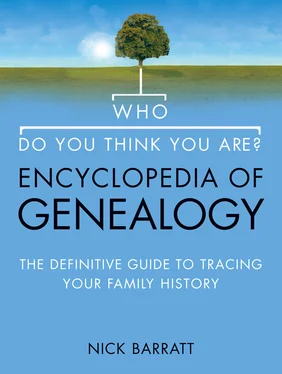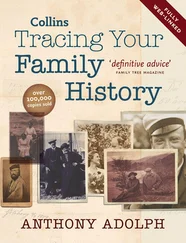There is even a network allowing you to search the holdings of university archives and libraries, called Archives Hub. It is being added to over time, and can be found at www.archiveshub.ac.uk.
Important Institutional Catalogues Online
It is always worth finding out if the archive you intend to visit has its own online catalogue accessed via its website. If you have located an archive using the ARCHON database, this should have provided you with their website address. Most of the national archives have separate online catalogues containing descriptions of documents not found on A2A or the NRA.
• The National Archives’ Catalogue has descriptions of an impressive 10 million documents that you can search by keyword, date range or government departmental code from www.nationalarchives.gov.uk/catalogue. The documents held at TNA are categorized according to the government department they originated from, and a departmental code forms the first part of any TNA document reference. For example, WO is the prefix of all document references for records from the War Office. Searching for document descriptions by government departmental code can help to narrow down the number of results you get if you know what type of record you are looking for.
• The National Archives of Scotland has a database known as OPAC (Online Public Access Catalogue) that can be found at www.nas.gov.uk/catalogues/default.asp. This searches their collections by keyword, place authority, name authority and date, and the NAS website has a list of documents that have not yet been uploaded to OPAC and require a search of the original indexes. You could also consult the National Register of Archives for Scotland (NRAS), which is only available in paper form at the National Archives of Scotland and the National Library of Scotland. This is a survey of papers held by private archives in Scotland.
… search for documents
1. Write down your research goals in advance, and keep them focused and manageable
2. Every item in an archive will have a unique catalogue reference and description
3. Document references will be contained in the archive’s catalogue index
4. Many archive catalogues are available to search online, although some are still only in paper form
5. Online catalogues are available either via the particular repository’s website, or as amalgamated catalogues of documents from local and national archives
• In a similar vein, the National Library of Wales has a full catalogue which can be found on its website www.llgc.org.uk through the ‘Search the Catalogue’ heading. Here books, periodicals, newspapers, maps, graphics, electronic publications and digitized records can be searched by keyword.
• The National Archives of Ireland’s search engine is organized in a slightly different manner, allowing you to search in one go the 19 databases comprised mainly of government departmental records. This is accessed from www.nationalarchives.ie/search but does not cover the entirety of the repository’s collections.
• The Public Records Office of Northern Ireland does not have a complete online catalogue either. There is a limited online index available from www.proni.gov.uk by following the Search the Archives link, where a Geographical Index locates parishes, Poor Law Unions and counties on a map, a Prominent Persons Index finds references for documents relating to individuals, a Presbyterian Church Index and a Church of Ireland Index lists those church records that have been microfilmed, and a Subject Index describes the types of records held at the PRONI.
• The Society of Genealogists, which charges admission for non-members, has its own catalogue known as SOGCAT available from its website www.sog.org.uk/sogcat/access. Here you can search an alphabetical index by parish name, surname or subject to see if they hold copies of the parish registers you are looking for, or records of a particular pedigree you are hoping to find.
Step Three: Working Responsibly in an Archive
Once you have scoured the online catalogues and indexes for all the archives you plan to visit, and have made lists of all the documents that sound useful to your studies, why not see if it is possible to order those documents in advance of your visit? Most of the websites mentioned have clear instructions on how to do this either online or over the phone if they offer an advanced ordering facility. Your next step is to brave your first visit to the archives …
… work in an archive
1. Only use pencil and a spiral-bound note pad to make notes
2. Don’t eat or drink in the reading room
3. Handle documents as little as possible
4. Respect your fellow researchers: turn mobile phones off and work quietly
5. Laptops and digital cameras are usually allowed, but check with the archivist first
Because the material they hold is unique and irreplaceable, there are rules and regulations that you will have to follow during your visit. Actually, these rules are there to help you make the most of your research trip, as well as protect the documents for other users.
Document preservation and conservation is an important part of archival work, and to ensure that documents are not damaged you will find that archives impose strict rules on what you can bring into the reading rooms with you, plus guidelines on document handling techniques. In general, the golden rule of archives is that you must work with pencils only – biros and pens are forbidden due to the potential harm they can cause to original material. Similarly, erasers and pencil sharpeners should not be used or placed near documents, as they can cause damage. There is usually a no eating or drinking rule in place for similar reasons, and this extends to cough sweets and chewing gum.
If you are unsure about how you should be handling an item, or you feel it is delicate, please ask an archivist to assist you. Most archives have a store of foam wedges, supports and weights to help set the document out in a way that carries a minimum risk of harm. Try to limit your own contact with the item; for example, if reading a line of text, do not run your finger along the document, as grease from your skin can cause damage. Instead, place a piece of white paper under the line of text to help you keep your place. If you are having difficulty reading faded text, ultraviolet lamps can often help pick out lost words. Similarly, maps and plans are often covered under clear protective sheets, and you should always ask before you attempt to trace a document.
The amount of material you can bring into the reading rooms will also be limited. Apart from banning pens, erasers and pencil sharpeners, it is likely that you will be asked to leave the majority of your research notes in a locker outside the reading room area, and bring in only spiral-bound note pads or sheets of paper stapled together; and what you can bring in will be probably searched on the way in and the way out. This is to prevent document theft; sadly, many items ‘go missing’ each year.
Finally, you should, wherever possible, respect your fellow researchers and work in silence. If you do need to confer with a friend or colleague, try to talk quietly and leave the reading room to do so. Mobile phones should be turned off or left in silent mode – there’s nothing more annoying than having your concentration disturbed by someone’s phone ringing! Most archives allow you to bring your laptop into the reading room, but you should also set them up so that they are silent when turned on. Digital cameras are also largely welcomed these days, though you need to obtain clearance first from the archivist if you want to take photos, as there could be copyright implications and not all cameras are ‘document friendly’.
Читать дальше












